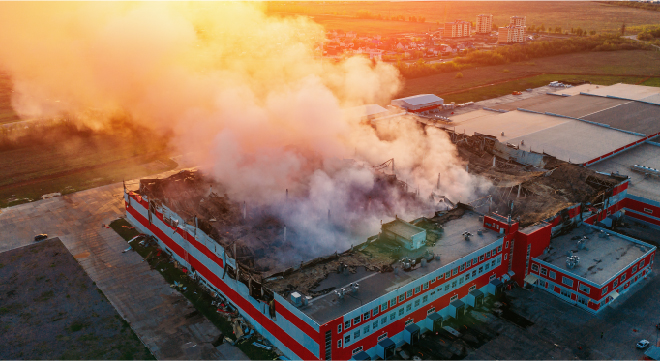Fires or explosions generated the most expensive losses for South African businesses over the past five years, accounting for 65% of the value of all claims, according to a study by Allianz Global Corporate & Speciality (ACGS).
Claims related to faulty workmanship or maintenance were the second-biggest cause of loss (20%) in South Africa.
Natural disasters – driven mainly by storm-related losses – damaged goods (including handling/storage), and defective product each accounted for 3% of the value of claims over the past five years.
However, the study was based on corporate insurance claims between January 1, 2017, and December 31, 2021. Therefore, it does not take into account claims arising from the floods in KwaZulu-Natal in April this year.
The study analysed 3 972 business claims in this country worth about €858 million (about R14.94 billion). The claims total includes the share of other insurers in addition to AGCS.
Read: Tough times call for innovative thinking
Water damage generated the highest number of corporate insurance claims in South Africa (about 30%), while one in five claims resulted from crime/wilful acts, according to AGCS’s 2022 Global Claims Review.
Meanwhile, Moody’s Investors Service said this week that underinvestment in water and electricity infrastructure made South Africa’s towns and cities vulnerable to events such as floods.
Capital expenditure in most of the country’s municipalities that Moody’s rates is below the 10% to 20% of total spending recommended by National Treasury, to ensure that infrastructure needs are addressed, the ratings company said.
“Physical climate events like floods and droughts can also expose infrastructure deficiencies and lead to severe water stress or blackouts,” Moody’s said. “These events can damage already poor infrastructure even further,” it said.
“Any losses or extended disruption related to the provision of services like water and electricity have severe credit implications,” Moody’s said. “The ineffective provision of electricity and water services also weighs on economic activity more broadly.”
Based on measures that suggest infrastructure was of low quality, weak financials and low governance, Tshwane and the Mangaung Metropolitan Municipality, which includes Bloemfontein, were most likely to see financial pressures related to water and electricity services intensify, Moody’s said.
Cape Town was best positioned to address these challenges, because of its much better financial position and access to debt markets, it said.
Top three causes of loss globally
Globally, the AGCS report found that the top three causes of loss (measured by the total value of corporate claims) between 2017 and 2021 were fire/explosion, natural catastrophes and faulty maintenance. These three causes accounted for 45% of the value of all losses.
This conclusion was based on AGCS’s analysis of 534 456 business insurance claims between January 1, 2017, and December 31, 2021, worth about €88.7bn (about R1.5 trillion).
Fire/explosion (excluding wildfires) was the largest single cause of corporate insurance losses, accounting for 21% of the value of all claims.
During the past five years, fire/explosion (including incidents such as building/factory fires, electrical fires, gas explosions and vehicle fires) have caused in excess of €18bn in insurance losses from more than 12 000 claims. They were responsible for 13 of the 20 largest non-natural catastrophe loss events analysed.
ACGS said claims were becoming more severe because of factors such as higher property and asset values, more complex supply chains, and the growth in concentrations of exposures.
The costs associated with the impact of business interruption following the aftermath of a fire can significantly add to the final total loss because of the time it can take to get production back up and running at a large manufacturing plant, “while soaring inflation will only challenge claims costs further”, the study said.
Natural catastrophes (15% of the value of all claims) rank as the second top cause of losses globally. Losses continue to rise with climate change and changes to exposures (such as increasing economic activity in natural catastrophe zones).
AGCS’s analysis of more than 20 000 claims from around the world, with an approximate value of €13.7bn, showed that hurricanes/tornados were the most expensive cause of natural catastrophe loss, accounting for 29% of the value of all claims, driven by the fact that two Atlantic hurricane seasons out of the previous five (2017 and 2021) rank among the top three most active and costliest seasons on record.
Collectively, the top five causes of loss – hurricanes/tornados (29%), storm (19%), flood (14%), frost/ice/snow (9%) and earthquake/tsunami (6%) – accounted for 77% of the value of all natural catastrophe claims.
Faulty workmanship/maintenance incidents were the third top cause of loss (accounting for 9% by value) and were the second-most frequent driver of claims (7% by number).
Expensive incidents include the collapse of building/structure/subsidence from faulty work, faulty manufacturing of products/components, or incorrect design.
The other top six causes of losses
- Aviation collision/crashes (9% of the value of all claims). In addition to major crashes, these losses include damage to aircraft caused during ground-handling incidents, over- and under-shooting runways, making an emergency or forced landing, or damage caused by a bird strike.
- Machinery breakdown, including engine failure (5% of the value of all claims) – for example, damage to industrial machinery, factory hardware, or a ship/aircraft/vehicle engine.
- Defective products (5% of the value of all claims) – for example, a large product recall; the cost of fixing defective automotive parts; lost business income due to premises closing because of defective goods; food contamination.
- Shipping incidents (3% of the value of all claims) – ship colliding with a harbour wall or another vessel, hull damage at sea, ship running aground, foundering or sinking.
- Damaged goods (3% of the value of all claims) – for example, vehicles damaged in transit; generator damaged by a power surge, equipment lost on premises, container contents damaged. These losses are the most frequent drivers of claims for insurers, accounting for 11% of all claims by number around the world.
- Professional indemnity claims (2% of the value of all claims) – for example, misleading advice, improper trading, breach of trust/fiduciary duties, breach of confidentiality.
- Water damage (2% of the value of all claims) – for example, boiler leak, flooding in basement, flooding due to burst pipes, general escape of water in commercial premises.
According to the analysis, almost 75% of financial losses arose from the top 10 causes of loss.




